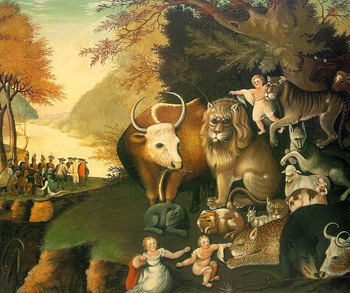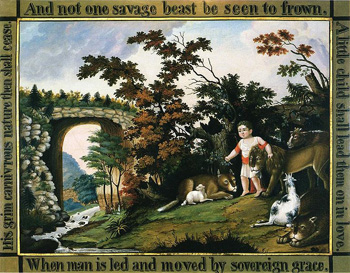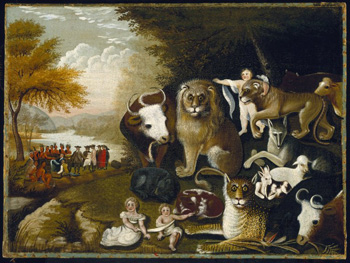The Peaceable Kingdom
A guest essay by novelist Ron Hansen. Ron's many books include Exiles (2008) and A Wild Surge of Guilty Passion (2011). Among his many honors are a Guggenheim Foundation grant, an Award in Literature from the American Academy and National Institute of Arts and Letters, two grants from the National Endowment for the Arts, and a three-year fellowship from the Lyndhurst Foundation. He is currently the Gerard Manley Hopkins, S.J. Professor in the Arts and Humanities at Santa Clara University, where he earned an M.A. in Spirituality in 1995.
For Sunday December 8, 2013
The Second Sunday in Advent
Lectionary Readings (Revised Common Lectionary, Year A)
Isaiah 11:1–10
Psalm 72:1–7, 18–19
Romans 15:4–13
Matthew 3:1–12
It has been said that the prime duty of the biblical prophets was to afflict the comfortable and comfort the afflicted. Our gorgeous passage from Isaiah is an example of the latter. Originating in Jerusalem in the 8th century B.C.E., this lengthiest of the Hebrew prophecy scrolls — the Nevi’im — was probably collected, reorganized, and augmented late in the 6th century when the fall of Babylon seemed near and the Jews could hope for a return to Judah.
“Isaiah son of Amoz,” the first of three authors responsible for the final text, seems to have written chapters 6–11 in a time of political crisis when Syria and the northern kingdom of Israel invaded the southern kingdom of Judah (later Judea) in order to force it to join their anti-Assyrian coalition. Ahaz was king of Judah then, a man in his late twenties who was viewed negatively in other biblical accounts for his religious apostasy and his final willing indenture to the King of Assyria.
 |
The Peaceable Kingdom (1826) by Edward Hicks. |
Without overtly judging Ahaz or his Jewish predecessors, Isaiah does offer an implicit criticism of their reigns in oracles about a glorious future king who would be even superior to the legendary David. Isaiah foretold that the dynasty that began with Jesse, David’s father, would produce an ideal ruler who would be filled with the spirit of the LORD and the same qualities that we now identify as the seven gifts of the Holy Spirit: wisdom, understanding, counsel, strength, knowledge, and fear of the LORD, which includes piety.
In the tradition of the Hebrew psalmists, Isaiah employs couplets containing parallel imagery to form a poetic description of a new Eden, initially stating a claim about the expected outcomes of the “shoot” of Jesse, then giving that statement further emphasis through a roughly equivalent pronouncement. Thus: “Not by appearance shall he judge, / not by hearsay shall he decide, / but he shall judge the poor with justice, / and decide aright for the land’s afflicted.” Worldly enemies — predators and prey — quietly inhabit this peaceable kingdom that is to come: wolf and lamb, leopard and kid, calf and lion, “with a little child to guide them.”
 |
Peaceable Kingdom of the Branch (c. 1826–1830) by Edward Hicks. |
Christians have long interpreted that child typologically, as a prefiguration of the baby born in Bethlehem more than two thousand years ago, whose goal it was to establish — “as water covers the sea” — the kingdom of God on earth. And in a rather startling example of prescience, Isaiah notes that this child, whom we know as Jesus, will be “a signal for the nations” and a rallying standard for even the Gentiles.
“The baby shall play by the cobra’s den, / and the child lay his hand on the adder’s lair.” That figurative illustration seems to have been behind John the Baptist’s affliction of the overly comfortable Pharisees and Sadducees. In our gospel account they are associated with Isaiah’s venomous snakes when John scolds them as a “brood of vipers.” And Matthew harkens back to the final stanza in chapter 10 of Isaiah, when he has John the Baptist proclaim, “Even now the ax lies at the root of the trees. Therefore every tree that does not bear good fruit will be cut down and thrown into the fire.”
Isaiah had written: “The Sovereign LORD of Hosts / Will hew off the tree crowns with an ax: / The tall ones shall be felled, / The lofty ones cut down.” [Isa 10:33]
 |
The Peaceable Kingdom (c. 1830–1840) by Edward Hicks. |
And later, in chapter 27 of Isaiah, the nation is compared to a productive orchard: “In days to come Jacob shall take root, / Israel shall blossom and put forth shoots, and fill the whole world with fruit.” [Isa 27:6]
In John’s preaching, there would soon be a day of wrath when those who had not fruitfully done good deeds would be destroyed, and neither the ritual of baptism in the Jordan nor their reliance on being children of Abraham would prevent the haughty religious leaders from being felled like rotten trees and thrown into the fire.
Crucial to John’s message was the need not only for repentance but for righteous activity as proof that a cleansing moral purity and conversion of heart had actually taken place.
In Christianity’s season of Advent — its time of expectant waiting and preparation for the birth of Jesus at Christmas — there are similar penitential themes that recall not just a historical event in Palestine but our contemporary need to prepare ourselves for the Second Coming of Christ, whose rule will be characterized by the hope and peace of Isaiah’s poetry as well as the fierce final judgment proclaimed by John.
Image credits: (1–3) Wikipedia.org.





